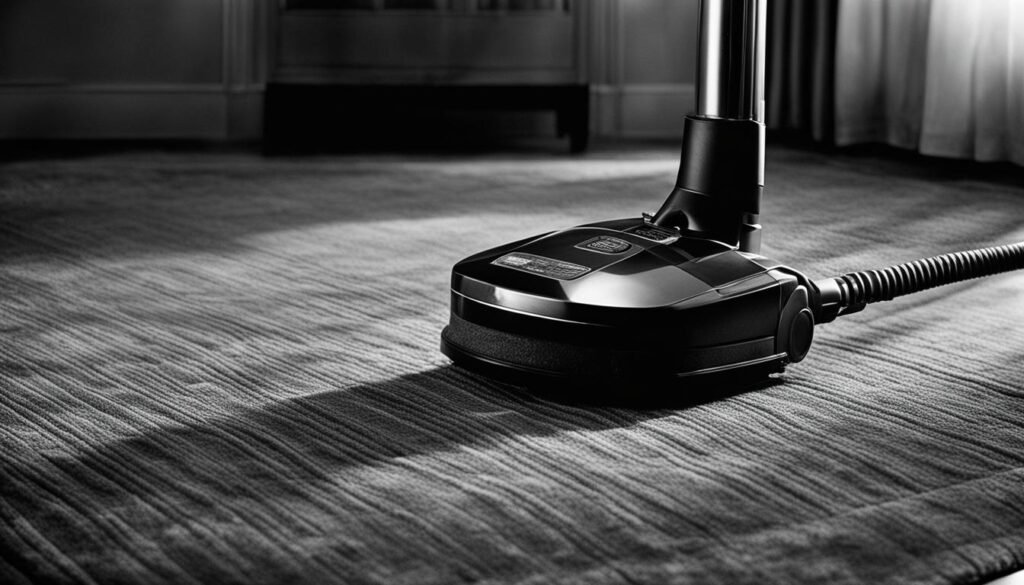The invention of the vacuum cleaner revolutionized household cleaning. In 1901, engineer Hubert Cecil Booth introduced the first effective vacuum cleaner. Inspired by a flawed machine he witnessed at a music hall demonstration, Booth set out on a mission to create a device that could suck up dust through a filter, rather than blowing it around. After near-fatal tests and experiments, Booth formed the British Vacuum Cleaner Company and launched his invention to the public. The first vacuum cleaner was a large, horse-drawn machine that attracted attention as it cleaned the homes of wealthy Londoners. Vacuum cleaners quickly gained popularity and became more portable and affordable over time. Today, they are an essential tool in every household.
Key Takeaways:
- The vacuum cleaner was invented by Hubert Cecil Booth in 1901.
- Booth was inspired by a flawed machine he saw at a music hall demonstration.
- The first vacuum cleaner was a large, horse-drawn machine.
- Vacuum cleaners gained popularity and became more portable and affordable over time.
- Today, vacuum cleaners are an essential tool in every household.
Continue reading to learn more about the evolution of vacuum cleaners and their impact on household cleaning.
The Evolution of Vacuum Cleaners: From Bellows to Electric Power
Before the modern vacuum cleaner, various cleaning tools were used throughout history, such as brooms and brushes. However, it was the invention of the vacuum cleaner that revolutionized the way we clean our homes. Let’s take a look at the timeline and development of vacuum cleaners, from their humble origins to the powerful machines we have today.
Early Innovations: Mechanical Carpet Sweepers
One of the earliest predecessors to the vacuum cleaner was the mechanical carpet sweeper, invented by Daniel Hess in 1860. This device featured a rotating brush and bellows for generating suction. While it was a significant step forward in cleaning technology, it still relied on manual operation.
“The mechanical carpet sweeper was an innovative solution for cleaning carpets. It helped remove dust and dirt more efficiently compared to traditional tools like brooms.”
Powered Cleaners: Blowing Dust and Suction
In the late 19th century, powered cleaners began to emerge. John S. Thurman invented a machine in 1898 that blew dust into a receptacle, but it lacked true suction capabilities. This was soon to change with the invention of the first vacuum cleaner to use suction, similar to today’s models, by Hubert Cecil Booth in 1901.
Inventions that Shaped the Industry
Following Booth’s invention, several key innovations took place that shaped the vacuum cleaner industry. Walter Griffiths designed the first portable vacuum cleaner in 1905, making it more accessible for individual households. James B. Kirby invented the “Domestic Cyclone” in 1906, which introduced cyclonic separation for improved dust collection.
“The inventions by Walter Griffiths and James B. Kirby made vacuum cleaners more convenient and efficient, setting the stage for future advancements in cleaning technology.”
The First Portable Electric Vacuum Cleaner
In 1907, James Murray Spangler, a janitor, created the first portable electric vacuum cleaner. This groundbreaking invention combined the power of electricity with the convenience of portability, paving the way for modern vacuum cleaner design. Spangler later sold the patent to William Henry Hoover, who founded the Hoover Company in 1908.
Key Milestones in Vacuum Cleaner Development
| Year | Event |
|---|---|
| 1860 | Daniel Hess invents the mechanical carpet sweeper. |
| 1898 | John S. Thurman creates a machine that blows dust into a receptacle. |
| 1901 | Hubert Cecil Booth invents the first vacuum cleaner with suction. |
| 1905 | Walter Griffiths designs the first portable vacuum cleaner. |
| 1906 | James B. Kirby invents the “Domestic Cyclone” with cyclonic separation. |
| 1907 | James Murray Spangler creates the first portable electric vacuum cleaner. |
These early inventions laid the foundation for the development and advancement of vacuum cleaners. From these humble beginnings, vacuum cleaners have evolved into the modern, efficient, and powerful machines we rely on today.
Vacuum Cleaners Become a Household Staple: The Rise of the Hoover
After the invention of the portable electric vacuum cleaner by James Murray Spangler, William Henry Hoover acquired the patent and founded the Hoover Company in 1908. The first Hoover vacuum cleaner, the Model O, was introduced in the same year.
The Hoover Company played a significant role in popularizing vacuum cleaners, with their products becoming synonymous with the term “Hoover” in the UK. The company introduced innovations such as the beater bar in 1919 and disposable filter bags in the 1920s. They also designed the first upright vacuum cleaner in 1926.
The Hoover vacuum cleaner became a status symbol, purchased by wealthy individuals and institutions like Buckingham Palace and the House of Commons.

Note: The image above showcases the iconic Hoover vacuum cleaner, representing the innovative advancements made by the Hoover Company during its rise to prominence.
| Year | Innovation |
|---|---|
| 1908 | Foundation of the Hoover Company |
| 1908 | Introduction of the Model O Hoover vacuum cleaner |
| 1919 | Beater bar innovation |
| 1920s | Disposable filter bags introduced |
| 1926 | Design of the first upright vacuum cleaner |
The Future of Vacuum Cleaners: Innovation and Automation
Vacuum cleaners have come a long way thanks to technological advancements, paving the way for a promising future. Today, consumers can choose from a wide range of options, including handheld battery-powered devices and cutting-edge robotic vacuum cleaners. These robotic marvels autonomously roam households, efficiently cleaning floors without human intervention.
However, the future of vacuum cleaners extends beyond robotic innovation. The rise of smart appliances and gadgets introduces a new era of convenience and efficiency in domestic tasks. Imagine a world where windows and ovens can self-clean, reducing the burden on homeowners.
Despite these exciting prospects, the nature of household chores and cleaning tasks remains relatively unchanged. While the future may bring further technological innovations in vacuum cleaner technology, it is uncertain whether they will significantly affect the time and effort invested in cleaning. Only time will reveal the true extent to which automation and smart technologies will shape the future of vacuum cleaners and revolutionize our domestic routines.
FAQ
Who invented the vacuum cleaner?
The first effective vacuum cleaner was invented by engineer Hubert Cecil Booth in 1901. He was inspired by a flawed machine he saw at a music hall demonstration and set out on a mission to create a device that could suck up dust through a filter.
When was the first vacuum cleaner invented?
The first vacuum cleaner was invented in 1901 by Hubert Cecil Booth.
What is the history of the vacuum cleaner?
Before the modern vacuum cleaner, various cleaning tools were used throughout history. The first mechanical carpet sweeper, an early predecessor of the vacuum cleaner, was invented by Daniel Hess in 1860. Powered cleaners were introduced in the late 19th century, and the first vacuum cleaner to use suction was invented by Hubert Cecil Booth in 1901. Since then, there have been continuous advancements in vacuum cleaner technology.
Who invented the first portable vacuum cleaner?
The first portable vacuum cleaner was invented by Walter Griffiths in 1905.
When was the first handheld electric vacuum cleaner invented?
The first handheld electric vacuum cleaner was invented by James Murray Spangler in 1907.
What is the significance of the Hoover vacuum cleaner?
The Hoover Company, founded by William Henry Hoover in 1908, played a significant role in popularizing vacuum cleaners. They introduced innovations such as the beater bar in 1919 and disposable filter bags in the 1920s. The company also designed the first upright vacuum cleaner in 1926. The Hoover vacuum cleaner became a status symbol and was purchased by wealthy individuals and institutions like Buckingham Palace and the House of Commons.
What are the future prospects for vacuum cleaner technology?
The future of vacuum cleaners holds potential for innovation and automation. We are already seeing advancements with robotic vacuum cleaners and smart appliances. However, it is uncertain to what extent these technologies will shape the future of vacuum cleaners and the overall time and effort spent on cleaning tasks in households. Only time will tell.






Leave a Reply